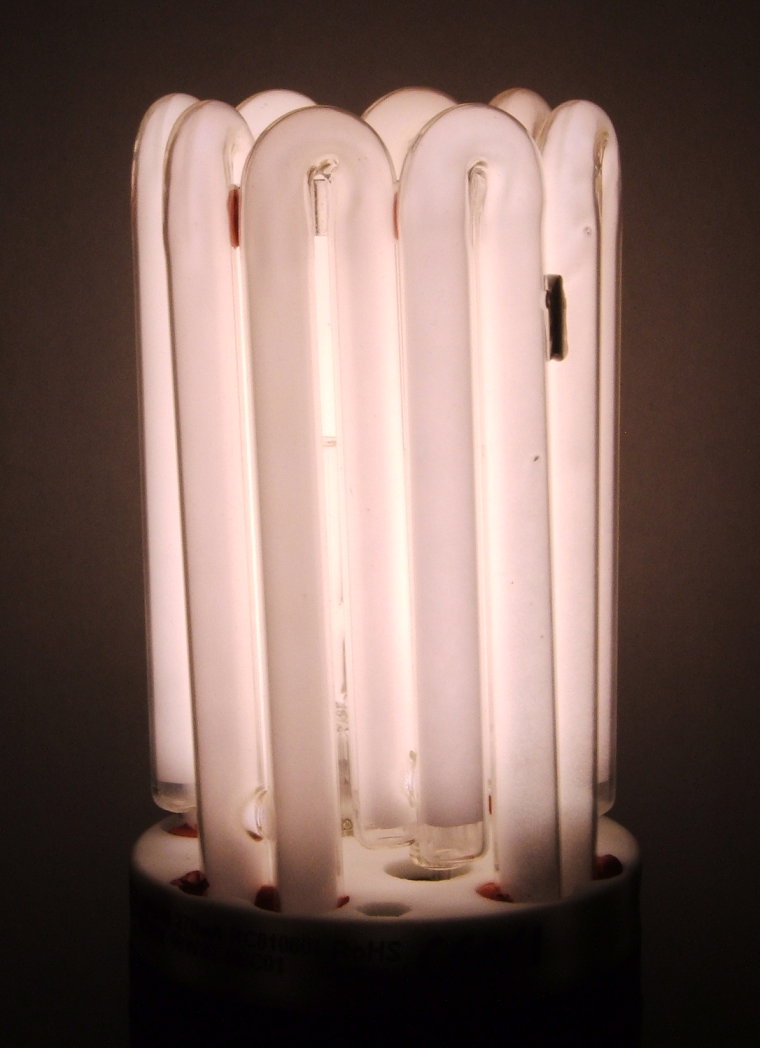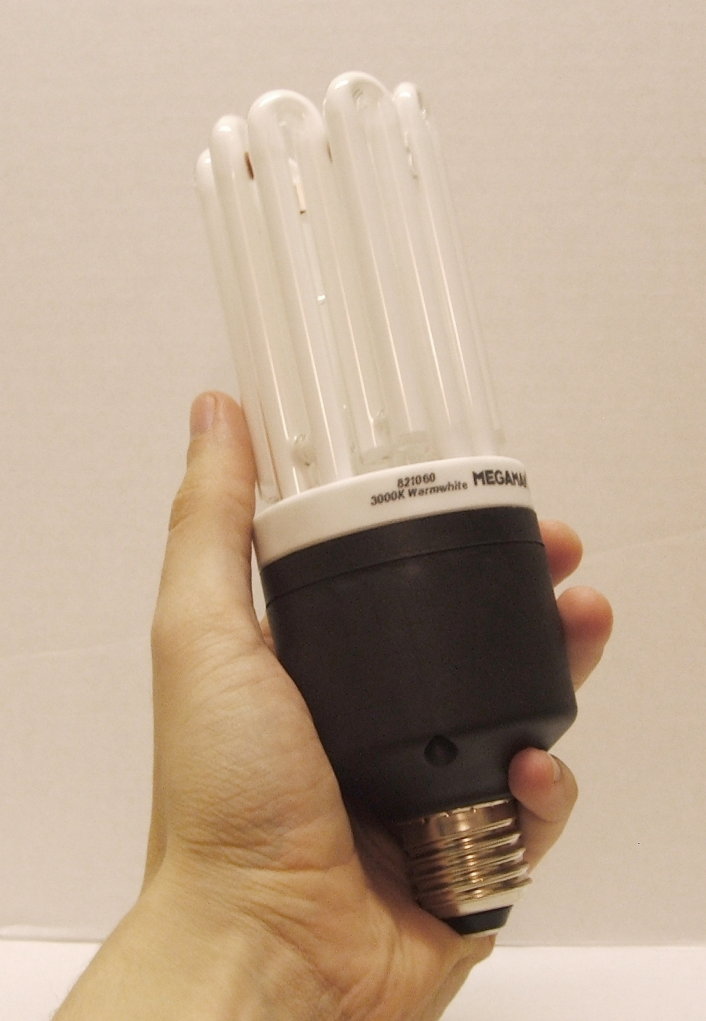
| Manufacturer: | Megaman |
| Model: | Clusterlite HC01060i 60W E27 3000K |
| Application: | General Lighting where high lighting levels are required |
| Wattage: | 60W |
| Diameter (max): | 60mm |
| Length: | 195mm |
| Tube Length: | 680mm (approx) |
| Bulb/Tube material: | Glass, warm white phosphor coating on inner wall |
| Colour Temperature: | 3000K. |
| Peak output wavelength: | N/A |
| Total light output: | 4000Lm (Manufacturers claim). |
| Rated lifetime: | 15000 Hours |
| Cap: | E27 |
| Operating voltage: | 220-240V AC 50-60Hz |
| Operating current: | 270mA |
| Warmup/restrike time: | 1 minutes/none (approx 0.5 second preheat before lamp lights) |
| Cost (original): | Unknown |
| Value (now): | GBP 30.90 from BLT Direct (Correct at time of writing) |
| Place of manufacture: | Unknown |
| Date of manufacture: | Assumed week 39, 2008 based on date code 08W39 on lamp. |
| Lamp Status: | Working, new. |
While in terms of
light output there are now CFLs which can match up to 100W
incandescent lightbulbs commonly available in every big supermarket
(especially now that 100W incandescents have disappeared from our
shelves for good), those larger than that are less common. If you
want a LOT of light, you're still limited to a few options:
High
wattage incandescent lamps - though with huge amounts of heat to deal
with and very high levels of power usage which need to be taken into
account.
Metal halide discharge lamps - Excellent colour
rendering in the case of the better lamps and with a small source which
is easy to focus into a beam using a relatively small reflector.
However there's a downside in that the lamps and their associated
control gear are very expensive. Many of the compact lamps
require fully enclosed fixtures as well.
Blended mercury lamps
are the only real option which doesn't require any external control
gear - though these don't offer any real advantages over halogen
incandescents other than in terms of lifetime.
However there
have been a few high power compact fluorescent lamps which are worthy
contenders - Megaman in particular seem to be pushing products such as
that pictured here - which is aimed right at the high power
incandescent or 100W metal halide market. While it's a lot
bigger than a 100W metal halide lamp, in the same breath, it's quite a
bit smaller than most 300W GLS incandescent lamps. Compared to
both of the above however, it's a lot more user friendly...not
requiring any external, bulky or expensive control gear, nor does it
double as a space-heater. All you need is a mains supply, an E27
lampholder, and some means of pointing the light where you want
it...which doesn't really need to be anything fancy unless you want a
tightly focussed beam. If you do want that, you're going to need
a truly massive reflector due to the large emissive area of the lamp,
so you'd probably be better looking at metal halide lamps.
If
however you're looking for a nice even floodlight, then you're in
business, as that's what CFLs are good for. So long as you've
got the tube itself shielded from direct view, this thing will easily
light any normal sized room to quite an impressive level in a nice
glare-free manner, while only using 60W of power.
Make no
mistake...this thing for all it's not as massive as the Saverlamp 85W
lamp which currently holds the record as the largest CFL I own...puts
out a lot of light. The packaging states that it's capable of
giving out 3000 lumens, and while it's hard to judge this without
having an integrating sphere - I don't reckon it's far off based on my
own rather subjective measurements.
One characteristic of this
lamp which I noted it seems to share with quite a number of modern
CFLs, especially some of those using narrow bore (T2 in this case)
tubing, is that when it's initially switched on that it starts out
really quite dim relative to its full output - thankfully given its
high rating that's still on par with a 100W incandescent, so unlike some
of the low wattage examples, one of which a friend of mine used in
their hallway meaning that when you flicked the switch on walking into
the dark house you were greeted with a dim pinkish glow barely better
than a couple of candles for the first five minutes! The power
dissipated in this lamp means that it warms up pretty quickly as well
I'd say it's as near as warmed fully up after a minute as makes no
difference.
I suspect that at least part of the reason that a
number of compact fluorescent lamps of late have been subject to low
initial output levels is somewhat due to the ever decreasing amount of
mercury which lampmakers are including in the burner in the interests
of being environmentally friendly. Interestingly, Megaman in the
case of the entire Clusterlite range have dispensed completely with the
liquid mercury dose, instead using an amalgam, apparently a mercury
alloy which is actually a solid at room temperature. While safer
in environmental terms, this does mean that the mercury vapour in the
lamp is likely to be too low for optimal performance when it's first
turned on. The level of paranoia surrounding the mercury content
of such lamps puzzles me somewhat anyway...while there is indeed some
liquid mercury in most CFL's, it's present in such a tiny amount that
even bearing in mind how many of these we go through in a year - I
rather doubt that it's a terrible environmental concern - it would seem
to make sense to me rather than to panic over it, to set up the
necessary schemes to ensure that used lamps can be properly (and
readily!) recycled...that way you avoid the problem of mercury escape
by making it available to lamp makers for use in a new lamp, therefore
reducing their costs and requirement for raw materials as I believe
it's possible for phosphors to be recovered as well, everybody wins.
Speaking
of phosphors, the box for this lamp states that its colour is "warm
white." It's not quite as warm white as you might be used to for
general home lighting however. Warm white tends to imitate normal
(non halogen) incandescent lighting, with a 2700K colour temperature.
3000K is actually a bit more of a neutral, slightly less yellowy
white. It's still warm - and fits in well with halogen
incandescent, but it's visibly whiter than most incandescent lamps or
colour 827 CFLs which may be undesirable in some locations. For
use in areas where a cooler, more daylight-like colour temperature are
desirable, there's a 4000K cool white version also available.
The
15,000 hour lifetime quoted on the packaging sounds impressive, and is
right up there with the HID alternatives. One very unusual
feature of this lamp is that it actually consists of two discharge
tubes and two ballasts - both rated to 30W. Assuming that these
ballasts are powered independently, this should allow one of the tubes
to continue to operate even if the other has failed, though obviously
this would result in a drastic drop in light output. That drop in
output would hopefully be noticed by someone, and result in the lamp
being replaced before it failed completely. For areas where
lighting is a safety-critical matter, this built in redundancy and
clear indication of impending failure could prove very useful indeed.
One
thing which I did notice about this light was that the high power
dissipation in conjunction with the narrow tubing results in a very
high wall temperature near to the electrodes, reaching well over 140
degrees Celsius in normal operation. You'd definitely want to
make sure that curious fingers were kept clear of this when in normal
use. I'd also hope that there's the appropriate protection
circuitry built into the ballasts to ensure that the lamp is shut down
at the end of the emitter life - as continued operation beyond this
point can lead to a drastic increase in the wall temperature around the
electrodes, result in cracking of the tube even in relatively low power
lamps.
The ballast in the case of this lamp does properly
preheat the electrodes before striking the discharge. This is a
feature which I like to see, as it can greatly increase the life of
lamps which are regularly switched on and off. The ballast in the
case of this particular lamp I've also noted does make a little noise,
nothing objectionable, just a very soft purr, strangely reminiscent of
the noise made by the magnetic ballast in a Philips SL*18 or SL*25,
albeit quite a lot quieter. It's by no means objectionable, but I
like to be thorough, and make sure that you know about these things.
It's
definitely an interesting lamp, and brings very high lighting levels
easily within the reach both financially and practically of the general
consumer. While GBP30 or so may seem a high price for a light bulb
- if it then lasts you the next ten to fifteen years of normal
usage...it's not that expensive, 2-3 pounds per year in fact, and if
you're comparing to a 300W incandescent, the savings in terms of power
will mount up quite quickly - based on our current electricity prices,
saving very nearly its own price in the first year (assuming 3 hours of
operation a day). As these prices seem to be spiralling out of
control at the moment, that payback period is likely to decrease.
This is in sharp contrast to the lower power lamps where the
return period in terms of energy costs can approach infinity in some
cases.
All in all, a very interesting lamp I think...now just to
go and find its big brothers. Megaman I've discovered also do 80W
and 100W versions like this, and 120W, 200W and an eye-searing 320W
version with an external ballast...I might need my sunglasses when
testing them.











This page created: 30th August 2009.
References: Lamp packaging, markings and manufacturers datasheets.
Acknowledgements: Many thanks to the website reader who donated this lamp and many others for display!
This page last updated on 13th June 2023: Changes to page formatting to improve readability on mobile devices and made some background code changes to improve search engine performance.